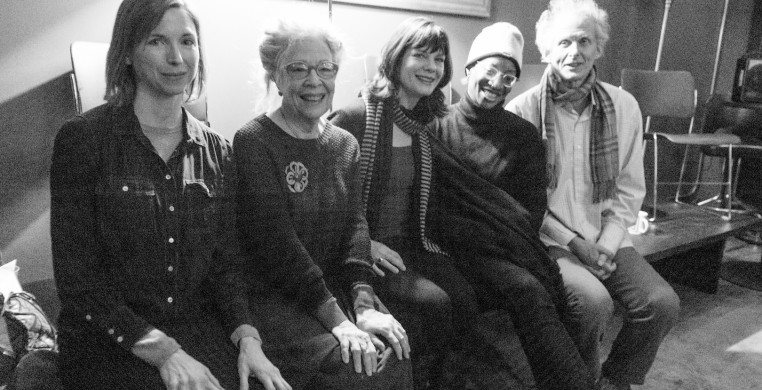By Sharon Hoyer
One might presume a panel discussion entitled “Women in the Director’s Chair” would be framed by gender issues, but the most recent Audience Architect’s Moving Dialog event was distinguished not by the sex, but by the age of the participants. The four distinguished dance educators and choreographers on the panel were part of aMID Festival at Links Hall, a two-week series of performances by mid-to-late career dancers and hosted by Zephyr Dance director Michelle Kranike. Kranike, along with Cynthia Oliver, Bob Eisen and Deborah Hay, sat down to discuss dance making from the perspective of dancers performing on stage in their 40s, 50s, 60s and 70s, respectively. And yet the conversation quickly transcended the topic of working at this or that age to the eternal questions artists strive to unravel over a lifetime.
Moderator Elise Archias opened the discussion by noting her interest in the project not only for the way it challenges our cultural obsession with youthful physiques, but with adolescent desires as well—the encouragement from mainstream advertising and entertainment to peruse our most basic impulses in the name of consumption over more mature desires to “construct a world in which more of us can thrive.” Her first question to the panel was what had changed in their creative process over the years. Hay responded first, hushing the room with her resonant, velvety alto: simplicity. As time passed she increasingly seeks simplicity in her work, trying to let go of more and more. In a similar vein, Bob Eisen talked about feeling more open to process…to, as Merce Cunningham observed, the ease of saying yes as opposed to judging if something is right or wrong. Cynthia Oliver’s response elicited the most knowing laugh from the crowd: how long it takes to warm up—about an extra half hour for every decade of life. In all seriousness Oliver noted, as did all the panelists, how much for her has stayed the same. She still feels fear every time she steps into the studio; she is still interested in language, she still feels risk in the creative process. Hay said that she still requires a space for play on a daily basis.
The next two questions, about the relationships in the four works presented and the audience each choreographer imagined addressing, drew out the striking differences in process and perspective between the four panelists. Eisen’s work, a duet with a younger male dancer, was highly structured and incredibly taut, with repetition of movement phrases and ideas that piled on to a near breaking point. Eisen sees his audience as the postmodern world “for better or worse.” Contrast that to Kranike’s 25-minute excerpt from her durational trio that has no dramatic arc, no trajectory, just three women performing a series of intertwining poses on a low platform against a bare wall. Kranike first stated that she didn’t care about keeping the audience’s interest, but that may not be entirely accurate. Her imagined audience, she said, goes on a journey of internal reactions, frustrations, emotions and, if all goes well, acceptance and openness to a slower, more present way of seeing. Hay stated that she is her audience and is always trying to pull the rug out from under herself. Her performance was an attentively observed solo that weaved between audience members seated on chairs and the floor, scattered throughout the performance space, and facing all directions. Oliver’s duet for herself and a younger woman provided another striking contrast, with spoken text, dialogue, humor, reference and straight-ahead contemporary dance-y moments. Oliver acknowledged multiple populations as her audiences: contemporary dance attendees, those who would identify references from her Afro-Caribbean roots and Black experience, and broader performance audiences who don’t necessarily see dance regularly. Between these four choreographers, the self, the other, dance audiences, non-dance audiences and no one specifically was addressed.
The greatest energy of the discussion gathered around a question from the audience about emotionality in the creation of work. Eisen—a postmodernist to the core—warned against the manipulation of emotions in art. “If you want emotion, go to a movie, watch a soap opera. There’s something higher we can strive for.” Oliver immediately took the mic to say how interested she is in emotion—how emotion defines the quality of movement on a very fundamental, textural level. Hay, always disarming, prefaced her answer by saying she has the emotional intelligence of a four year old, then talked about her effort to detach from her emotions as she observes them arising, pursuing non-linear creation in her dances. Oliver quickly countered to say that emotion is abstract, non-linear, and full of eruptions, not a path to follow but a mine of surprises to uncover. Hay then observed that they might well be talking about the same thing.
Were you to gather four artists whose work was respectively rooted in postmodernism, minimalist experimentation, and theatrical contemporary dance from any generation their views would be no less dissimilar. But the grace, humor, easy self-confidence and mutual respect characterizing the conversation between these artists are products of a wisdom that only comes with maturity. Early in the discussion, Bob Eisen stated that as he ages, he puts less weight on making dances than when he was young: “What’s happening in Syria right now, a young man being shot on the South Side of Chicago, these are big deals. What we do is a luxury.” Eisen is still grounded in the same postmodern aesthetics that have been the foundation of his career, but his perspective on those ideas has evolved.
The final question of the night came from an audience member who asked if there are creative questions that have expired. Hay responded that questions don’t so much expire as get re-articulated. “It doesn’t end. You as the artist just get a finer and finer relationship with the question.”
Sharon Hoyer, Dance Editor for Newcity Magazine

